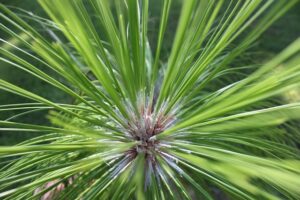
Greetings, subscribers. As promised, here’s the third post about Earth Care by my friend, the naturalist and author, Peg Sias Lantz. Let’s learn a little something about pine trees …
The unique longleaf pines
When my Dad was eight years old, his Dad moved the family to Lake Lucy, [Florida] where I live now. My Dad told me the whole area was surrounded by longleaf pine trees in all stages of development. He said he and his brother could climb a young tree to the top, and it would bend over toward another pine, making it possible for them to go around the lake from tree to tree without touching ground. He once told me he found a longleaf pine needle 24 inches long. I have one Scotch-taped to my bookcase that I found – it’s 22 inches long.
Where are longleaf pines?
Longleaf pines used to cover the entire southeastern coastal strand from Texas to Virginia (including Oakland and Winter Garden) – 90 million acres. They were cut for log cabins, homes, ship masts, and railroad ties, and turpentined for naval stores, and later to plant citrus groves and slash pine plantations. Only five million acres remain, and the only remaining old growth pine forest in Florida is on Eglin Air Force Base in the Panhandle.
A longleaf pine forest is different from northern hardwood forests. The trees grow far apart, and the undergrowth consists of beautiful wildflowers, such as goldenrod, blazing star, and beautyberry, and grasses, especially one called wiregrass, which grows only in association with longleaf pines. Pioneers traveling to Florida would comment on how easy it was for their horses to navigate through the pines.
This special forest was – and is – home to thousands of species of plants and animals found nowhere else on the planet – terrestrial orchids and Red-cockaded Woodpeckers, as well as fox squirrels, quail, and gopher tortoises.
One man’s pine tree adventures
Years ago, when freezing weather had killed a lot of citrus groves, [name withheld] of our congregation replanted his dead grove with pine trees. A couple of years later, he came to me in the fellowship hall after church and said he had planted a row of longleaf pines every three rows or so among rows of slash pines. “The slash pines are doing great,” he said, “but the longleaf pines seem to have all died.”
“Show me,” I said.
We drove to his fields, and sure enough, his slash pines were mostly two or three feet tall, and there was no sign of any longleaf pines. We walked out to where there should have been a row of longleaf pines. I leaned over and parted the grasses.
“There’s one,” I said, pointing to what looked like a bit of greener grass among the browner grasses.
I took a few more steps and showed him another. And another. They were all there. They were still in what we call the “grass stage” of growth.
When a longleaf pine seed germinates, the root develops before needles appear. A tiny showing of needles may stay in grass stage for five or more years, while the taproot is extending downward, providing support and seeking moisture. The root may be three feet long, storing up energy, while the needles are still only six or eight inches above ground.
If a fire should come through, the growing tip is protected by lying low in the sand, while its needles may burn off.
Then, when it is ready, it may shoot up three feet in one summer.
When a slash pine is three feet tall, it may already have side branches, looking like a miniature of its adult self. But a longleaf grows only upward. We call this the “bottle-brush stage”, with needles all up and down its trunk and a big bushy brush at the top. Now, the longleaf pine is out of reach of a fire creeping through the grasses, and its naturally thick bark is almost impervious to fire.
In the spring, the new needles of a longleaf look plump and whitish, while the new needles of a slash form a thin brown spike. When they are maybe 15 to 30 feet tall, I cannot tell them apart except in the spring. But when they reach maturity and older, the slash will still be telephone-pole straight, while a longleaf will begin to sprawl at the top.
Slash pines are not long-lived, even if they are not cut for pulp or fence posts. But a longleaf pine can live for two or three hundred years.
I am in the process of restoring my overgrown five-acre woods to its hundred-year-old longleaf pine sandhill habitat. If you’d like to know more about this wonderful tree, check out The Longleaf Alliance – The Longleaf Alliance
—END—
Thanks for reading!
Your writer on the wing,
Charlene
.







Kathleen Brandt
And I just thought pine trees were pine trees!
Charlene
Yeah, me too.